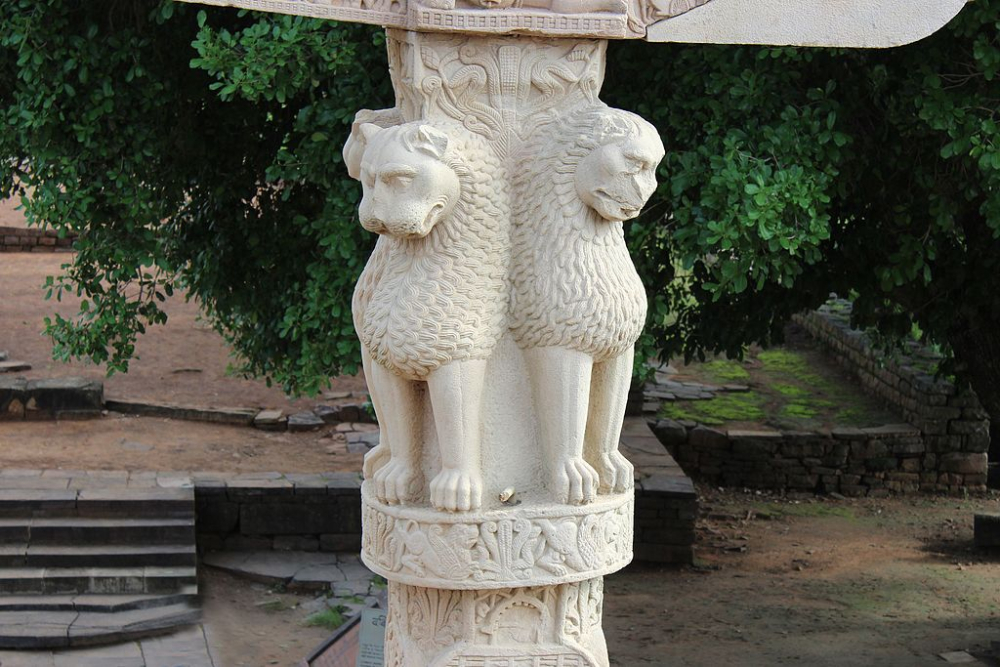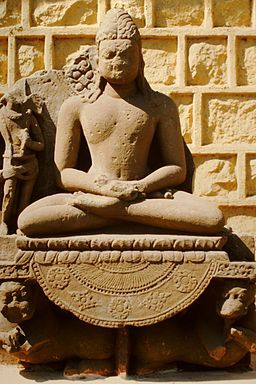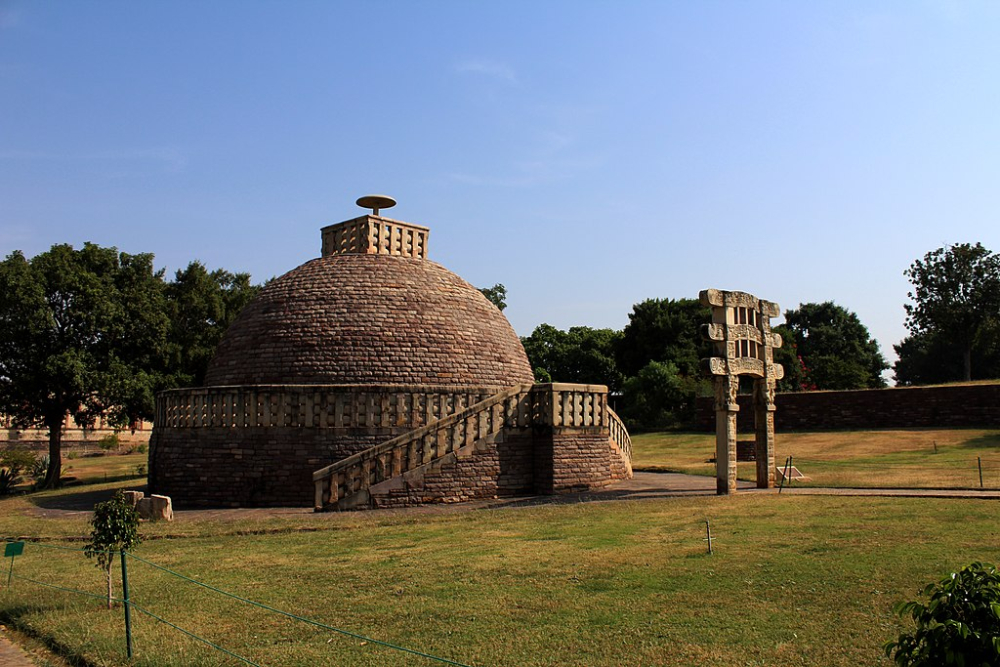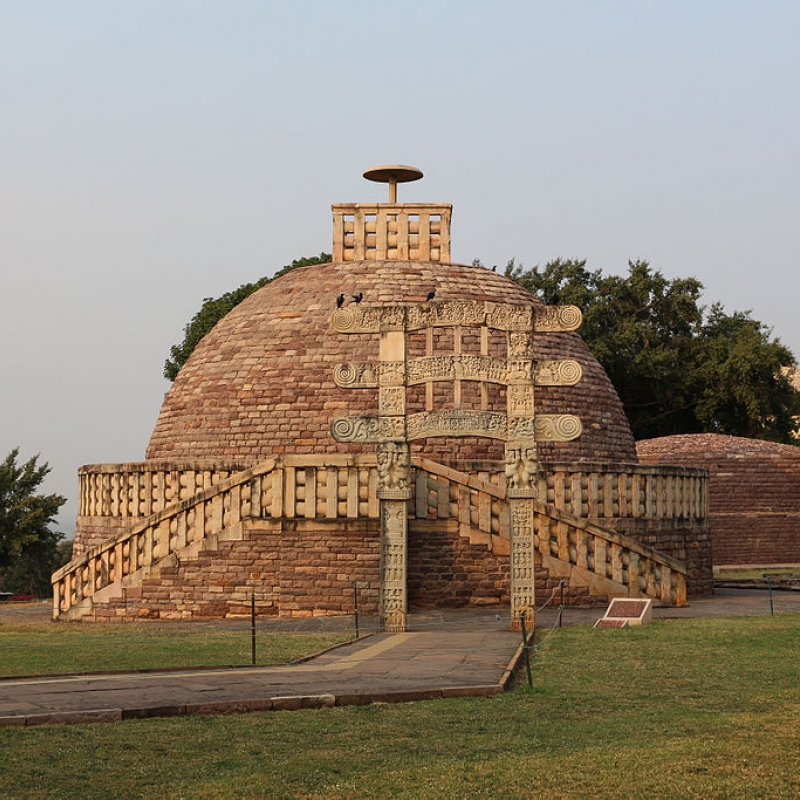Located near Bhopal, the Sanchi Stupa is living proof of India’s artistic and architectural history. The Mahastupa, one of India’s oldest stone structures, lies among the country’s best-preserved group of Buddhist monuments—ancient and sacred architectural wonders that were collectively designated a UNESCO World Heritage site in 1989. (Photo Courtesy: Bernard Gagnon [CC BY-SA 3.0])
The Sanchi Stupa is one of India’s primary Buddhist sites and contains some of the oldest stone structures in the country. It took seven years of dedicated excavation and restoration by the Archaeological Survey of India (ASI)—under the supervision of Director-General John Marshall between 1912 and 1919—to make the world realise its true splendour and importance. This was in spite of the fact that Sanchi witnessed the establishment, flourishing and subsequent decline of Buddhist education and thought over almost 1,500 years. Interestingly, Buddha never visited Sanchi. Neither did foreign travellers like Xuanzang (Hiuen Tsang), who extensively documented the holy Buddhist circuit in India and made no mention Sanchi in his writings.
It is no wonder then that Marshall, in The Monuments of Sanchi (1938), wrote that Sanchi was not as revered as other Buddhist pilgrimage sites in India. Yet, these stunning monuments, with their magnificent carvings and inscriptions, are reflective of Indian architecture from the Mauryan era (third century BCE) to its later medieval-era decline (around 11th century CE).

The Sanchi complex is famous for the Mahastupa (Great Stupa), the Ashokan pillar (with its inscriptions) and its signature ornate torans (gateways). (Courtesy: Suyash Dwivedi [CC BY-SA 4.0])
Scholars like Alfred A. Foucher say that the aniconic depictions of Buddha (as the Bodhi tree, a rider-less horse, an empty throne, etc.) at Sanchi are products of Graeco-Buddhist architectural interaction, while others argue that it was considered inappropriate to depict someone who had attained nirvana. The earliest-known depiction of Buddha in human form came almost a century later.
Also Read | Hawa Mahal, More Than Just a Breezy Affair
The Sanchi complex is famous for the Mahastupa (Great Stupa), the Ashokan pillar (with its inscriptions) and its signature ornate torans (gateways). The style of the torans and fencing is said to mimic the bamboo craft of the surrounding areas. ‘If one looks at the design of the fencing around the stupa, as well as the way the torans have been designed (with two side panels and three intersecting horizontal panels at the top), they’re reminiscent of bamboo craft and tied bamboo,’ says Sahapedia consultant and former deputy director of Delhi’s Crafts Museum, Mushtak Khan.
Why Sanchi?
Nestled in the Vindhya Range, 46 km from Madhya Pradesh’s capital Bhopal, the historical city of Sanchi also boasts 50-odd other monuments, including temples and monasteries. The Mahastupa was built by King Ashoka (304–232 BCE) in the third century BCE to house the relics of Gautam Buddha (obtained by opening the eight primary stupas located at places relevant to Buddha’s life, these were further scattered across 84,000 stupas to spread the influence of Buddhism). While it’s unclear why Ashoka chose this specific site for a Buddhist monument, some scholars opine that it could have been the influence of his first wife Devi—who primarily oversaw the construction of the Mahastupa—coupled with the site’s proximity to the rock-cut caves of Udayagiri.
Inscriptions on the southern toran vouch that the ivory workers of erstwhile Vidisha (now Besnagar) worked on these monuments, translating the same intricate talent onto stone.
Destruction and Restoration
Stupas are semi-spherical domes with square bases that contain small receptacles for relics. There is generally a path for circumambulation around the outer structure of the stupa. They were initially built outside monasteries by pilgrims. The Sanchi Mahastupa is regarded as one of the first monastic stupas. After the reign of the Mauryas, the Sanchi Stupa was vandalised by Pushyamitra Shunga in the mid-second century BCE. It was later encased in stone, rebuilt and expanded by future Shunga kings during 187–78 BCE. The four signature torans—embellished with scenes from the Jataka Tales, Ashoka’s visit to the Bodhi tree, the war for Buddha’s relics, etc.—were also later additions, constructed by the Satavahanas between first century BCE and first century CE.

One of the first accounts of the Sanchi Stupa came from the British captain Edward Fell in 1819 and it took 93 years for the site to be ‘rediscovered’ by John Marshall (Courtesy: Arnold Betten [Public domain])
The main stupa was originally smaller, and was expanded to its current height of 54 ft under the Shungas. The harmika (square rail unit) surmounting it, the yashti (mast) representing the cosmic axis and the chhatras (umbrellas) signifying the many heavens were also added during this period. Along with a chaitya vihar (assembly hall) and an early fifth-century Gupta temple with a pillared portico, the site also houses two other stupas—one (first century BCE) sports Shunga-period railing decorations and the other (first century BCE–first century CE) has a single toran.
Also Read | Lotus Temple and the Number Nine
One of the first accounts of the Sanchi Stupa came from the British captain Edward Fell in 1819. It was a further 93 years before the site was ‘rediscovered’ by John Marshall, and an additional seven before it was restored to its current glory. In 1919, Marshall opened the museum that houses all the site’s antiquities—the most important being the polished-sandstone lion capital from the Ashoka pillar, containing inscriptions warning monks against wavering from the path of dhamma and causing divisions among the ranks.

After the reign of the Mauryas, the Sanchi Stupa was vandalised by Pushyamitra Shunga in the mid-second century BCE. It was later encased in stone, rebuilt and expanded by future Shunga kings during 187–78 BCE (Courtesy: Varada Phadkay [CC BY-SA 4.0]
Inspiration for Future Architects
The lion capital at Sanchi is similar to the one at Sarnath. The main difference between the two is that the monument at Sanchi depicts an abacus instead of a chakra. However, the influence of the Sanchi Stupa on our national psyche goes beyond the lion capital; it inspired the design of several modern buildings, chief among which is the modern-day Rashtrapati Bhavan. Architect Edwin Lutyens was asked by Lord Charles Hardinge to incorporate symbols of India’s architectural past into the building, and modelled the colonnade to carry a Sanchi-style dome and balustrade railing. In 1963, the dome of Kolkata’s Birla Planetarium was constructed to mirror the one at Sanchi. This was followed by similar constructions at the Ambedkar Udyan and the Ambedkar Samajik Parivartan Sthal in Lucknow.
Did You Know?
-
The new 200-rupee note introduced in 2017 carries an illustration of the Sanchi Stupa.
-
There were two attempts to export a toran in the mid-nineteenth century (once by a Bhopal queen and then by the British government). Ultimately, a replica of the eastern gateway was shipped in 88 special cotton-lined boxes, to be assembled for display at the South Kensington Architectural Courts in 1869–70
-
A Vajrapani pillar, which once stood near the northern gateway, now lies in the Victoria and Albert Museum, London.
-
A damaged torso of a yakshini (a mythical being in Buddhist, Hindu and Jain lore) is preserved at the Museum of Fine Arts, Boston.
This article was also published on The Indian Express.












